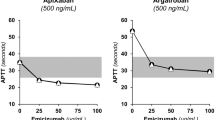Abstract
In pregnant women, activated partial thromboplastin time (APTT) does not precisely reflect the anticoagulant effect of a therapeutic dose of heparin. However, the measurement of anti-Xa activity can be used to monitor the anticoagulant effect of heparin, since the plasma concentrations of coagulation factors increase in pregnant women. We evaluated the in vitro effects of increased concentrations of fibrinogen and other coagulation factors (FVII, FVIII, and FIX) on the results of assays of APTT and anti-Xa activity in plasma samples with various therapeutic concentrations of unfractionated heparin (UFH). In the presence of UFH, APTT was shortened by increased concentrations of fibrinogen, FVII, or FVIII, and this effect was much stronger when the FVIII concentration was increased. In the plasma samples containing 0.5 or 0.7 U/mL of UFH, the APTT was shortened by approximately half or one-third, respectively, when 6 U FVIII/mL was added to the sample. The anti-Xa activity was not influenced by increased concentrations of the coagulation factors. In the present study, we also evaluated the sensitivities to UHF of four APTT reagents, and found a 1.65-fold difference in the sensitivity to UFH among APTT reagents. Our results demonstrate that increased FVIII concentration shortens APTT under therapeutic doses of UFH, and that APTT thus underestimates the anticoagulant effect of UFH in pregnant women, mainly due to the increased FVIII concentration.



Similar content being viewed by others
References
Basu D, Cade J, Gallus A, Hirsh J. A prospective study of value of monitoring heparin treatment with activated partial thromboplastin time. N Engl J Med. 1972;287:324–7.
Raschke R, Hirsh J, Guidry JR. Suboptimal monitoring and dosing of unfractionated heparin in comparative studies with low-molecular-weight heparin. Ann Intern Med. 2003;138:720–3.
Hirsh J, Raschke R. Heparin and low-molecular-weight heparin:the seventh ACCP conference on antithrombotic and thrombolytic therapy. Chest. 2004;126:188S–203S.
Garcia DA, Baglin TP, Weitz JI, Samama MM. American College of Chest Physicians. Parenteral anticoagulants: antithrombotic therapy and prevention of thrombosis, 9th ed: American College of Chest Physicians Evidence-based clinical practice guidelines. Chest. 2012;141:e24S–43S.
Eikelboom JW, Hirsh J. Monitoring unfractionated heparin with the APTT: time for a fresh look. Thromb Haemost. 2006;96:547–52.
Vandiver JW, Vondracek TG. Antifactor Xa levels versus activated partial thromboplastin time for monitoring unfractionated heparin. Pharmacother. 2012;32:546–58.
Kitchens CS. To bleed or not to bleed? Is that the question for the PTT? J Thromb Haemost. 2005;3:2607–11.
Levine MN, Hirsh J, Gent M, Turpie AG, Cruickshank M, Weitz J, et al. A randomized trial comparing activated thromboplastin time with heparin assay in patients with acute venous thromboembolism requiring large daily doses of heparin. Arch Intern Med. 1994;154:49–56.
Chunilal SD, Young E, Johnston MA, Robertson C, Naguit I, Stevens P, et al. The APTT response of pregnant plasma to unfractionated heparin. Thromb Haemost. 2002;87:92–7.
Morabia A. Heparin doses and major bleedings. Lancet. 1986;1:1278–9.
Gouin-Thibaut I, Martin-Toutain I, Peynaud-Debayle E, Marion S, Napol P, Alhenc-Gelas M, et al. Monitoring unfractionated heparin with APTT: a French collaborative study comparing sensitivity to heparin of 15 APTT reagents. Thromb Res. 2012;129:666–7.
Teien AN, Lie M, Abildgaard U. Assay of heparin in plasma using a chromogenic substrate for activated factor-X. Thromb Res. 1976;8:413–6.
Wool GD, Lu CM. Acad Clinical Lab Phys Scientists. Pathology consultation on anticoagulation monitoring factor X-related assays. Am J Clin Pathol. 2013;140:623–34.
Stirling Y, Woolf L, North WR, Seghatchian MJ, Meade TW. Haemostasis in normal pregnancy. Thromb Haemost. 1984;52:176–82.
Szecsi PB, Jorgensen M, Klajnbard A, Andersen MR, Colov NP, Stender S. Haemostatic reference intervals in pregnancy. Thromb Haemost. 2010;103:718–27.
Brancazio LR, Roperti KA, Stierer R, Laifer SA. Pharmacokinetics and pharmacodynamics of subcutaneous heparin during the early third trimester of pregnancy. Am J Obstet Gynecol. 1995;173:1240–5.
Chiu HM, Hirsh J, Yung WL, Regoeczi E, Gent M. Relationship between anticoagulant and antithrombotic effects of heparin in experimental venous thrombosis. Blood. 1977;49:171–84.
Acknowledgments
This work was supported in part by grants-in-aid from the Ministry of Health, Labor, and Welfare of Japan, the Japan Society for the Promotion of Science, the Uehara Memorial Foundation, and the Takeda Science Foundation.
Conflict of interest
The authors declare no conflict of interest associated with this manuscript.
Author information
Authors and Affiliations
Corresponding author
About this article
Cite this article
Mitsuguro, M., Okamoto, A., Shironouchi, Y. et al. Effects of factor VIII levels on the APTT and anti-Xa activity under a therapeutic dose of heparin. Int J Hematol 101, 119–125 (2015). https://doi.org/10.1007/s12185-014-1702-z
Received:
Revised:
Accepted:
Published:
Issue Date:
DOI: https://doi.org/10.1007/s12185-014-1702-z




